JNCI: Why will Breast cancer still recur after 30 years?
- A Single US$2.15-Million Injection to Block 90% of Cancer Cell Formation
- WIV: Prevention of New Disease X and Investigation of the Origin of COVID-19
- Why Botulinum Toxin Reigns as One of the Deadliest Poisons?
- FDA Approves Pfizer’s One-Time Gene Therapy for Hemophilia B: $3.5 Million per Dose
- Aspirin: Study Finds Greater Benefits for These Colorectal Cancer Patients
- Cancer Can Occur Without Genetic Mutations?
JNCI: Why will Breast cancer still recur after 30 years?
- Red Yeast Rice Scare Grips Japan: Over 114 Hospitalized and 5 Deaths
- Long COVID Brain Fog: Blood-Brain Barrier Damage and Persistent Inflammation
- FDA has mandated a top-level black box warning for all marketed CAR-T therapies
- Can people with high blood pressure eat peanuts?
- What is the difference between dopamine and dobutamine?
- How long can the patient live after heart stent surgery?
JNCI: Why will Breast cancer still recur after 30 years? What kind of patients are at the highest risk?
Thanks to the development of mammography technology, the early diagnosis and treatment of breast cancer patients are becoming more and more effective, and the survival rate of patients has also been improved [1].
However, among estrogen receptor (ER)-positive and HER2-negative breast cancer patients, at least half of the patients relapse 5 years after the initial diagnosis [2].
Therefore, the current adjuvant endocrine therapy for breast cancer has been extended to 10 years [3].
So, after these 10 years? Will advanced breast cancer make a comeback? What kind of patients need long-term follow-up? These problems still need to be tested by longer-term clinical studies.
Recently, Rikke Nørgaard Pedersen and colleagues from Aarhus University in Denmark published their 32-year research results in the Journal of the National Cancer Institute .
The results of the study showed that during the 10-32 years after the initial diagnosis, the incidence of advanced breast cancer was 15.53%, and the cumulative incidence at the 32nd year was 16.6% [4].
More importantly, they found that when breast cancer patients were first diagnosed, the tumors were larger (diameter> 20mm), the number of lymph nodes involved (≥4), estrogen receptor (ER) positive tumors and 10-25 after diagnosis Years of cumulative incidence of advanced breast cancer and increased risk of recurrence are related [4].
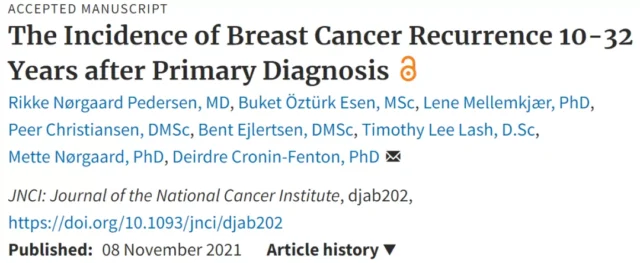
Screenshot of the paper’s homepage
Approximately 75% of primary breast cancer tumors have spread locally or remotely at the time of diagnosis [5].
These spreading tumor cells can even exist in disease-free survivors of breast cancer even decades after the treatment of the primary tumor [6], in order to progress to advanced breast cancer.
A Danish study showed that the risk of local recurrence in patients with early breast cancer 20 years after the initial diagnosis was 15%, and the risk of remote recurrence was 21% [7].
Another large meta-analysis showed that the risk of distant recurrence of breast cancer patients was between 13% and 41% during the 5-20 years after the initial diagnosis, and proposed that the risk of remote recurrence is strongly correlated with baseline lymph node involvement [ 8].
In order to better understand the risk of recurrence of advanced breast cancer, Pedersen and his colleagues analyzed the recurrence of breast cancer patients during the 10-32 years after the initial diagnosis, and assessed the tumor diameter, tumor grade, and lymph nodes.
The correlation between factors such as the degree of involvement and the risk of recurrence within 10-32 years.
Therefore, they obtained information from the clinical database of the Danish Breast Cancer Group for all women diagnosed with early breast cancer (n=36924) between 1987 and 2004, and tracked them from the date of the first diagnosis. After screening, a total of 20,315 10-year disease-free survivors were finally included for follow-up until the recurrence of advanced breast cancer, second cancer, migration, death, or the end of the study.
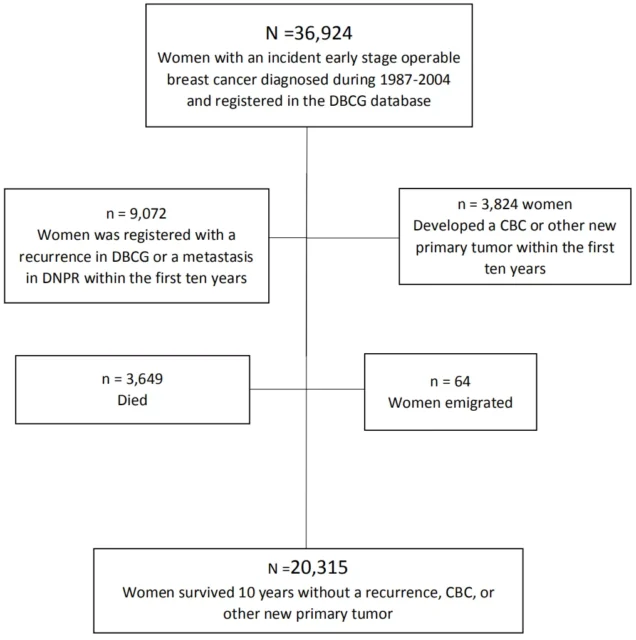
More than 50% of patients have not had advanced breast cancer recurrence within 10 years
Of these 20,000 10-year disease-free survivors, a total of 2,595 relapsed within 10-32 years after the initial diagnosis .
The median follow-up time was 7 years (that is, 17 years after the initial diagnosis), and the median age was 55 years.
Overall, the incidence of advanced breast cancer within 10-32 years after the initial diagnosis is still 15.53% (95%CI 14.94-16.14).
Among them, the incidence rate was the highest in the 10-12 years after the initial diagnosis , reaching 22.10% (95% CI = 20.89-23.37).
From the perspective of cumulative incidence, the cumulative incidence of advanced breast cancer at 15, 20, 25, and 32 years after initial diagnosis reached 8.5% (95%CI 8.1%-8.9%) and 12.5% (95%CI 12.0%-13.0). %), 15.2% (95%CI 14.6%-15.7%) and 16.6% (95%CI 15.8%-17.5%).
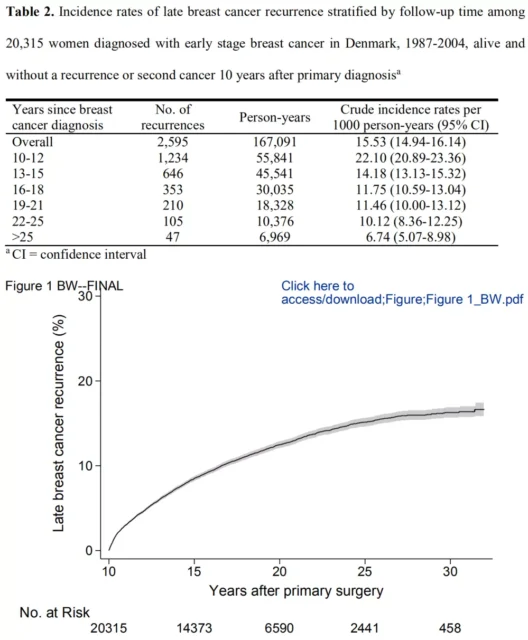
Top image: Incidence rates in different time periods 10-32 years after diagnosis; Bottom image: Cumulative incidence rates during 10-32 years after diagnosis
Pedersen and his colleagues further evaluated the correlation between factors related to the potential risk of late recurrence of breast cancer (tumor diameter, lymph node involvement, tumor grade, etc.) and the patient’s 10–25 year outcome. The results show that:
The cumulative incidence of lymph node involvement number of related , ranging from% 12.7 (T1N0) to% 24.6 (T2N4-9) .
When the number of positive lymph nodes at the first diagnosis was ≥4, the risk of recurrence increased by 167% (HR 2.67; 95%CI 2.31-3.08), and the risk of distal recurrence increased nearly three times (HR 3.75; 95%CI 3.07-4.59).
The cumulative incidence is related to the histological grade of the tumor , ranging from 7.5% (Grade III and no lymph node involvement) to 37.9% ( G rade I and the number of positive lymph nodes ≥ 4) .
Newly diagnosed when G Rade III , the recurrence risk reduction 43% (HR 0.57; 95% CI 0.48-0.66), a proximal end, a distal end to reduce the risk of recurrence by 30%, 51%.
The cumulative incidence of tumor diameter associated , tumor diameter ≤20mm 14.4%,> 15.5% of 20mm .
When the tumor diameter was greater than 20mm at the first diagnosis, the risk of recurrence increased by 23% (HR 1.23; 95% CI 1.13-1.35), and the risk of local or distal recurrence was similar.
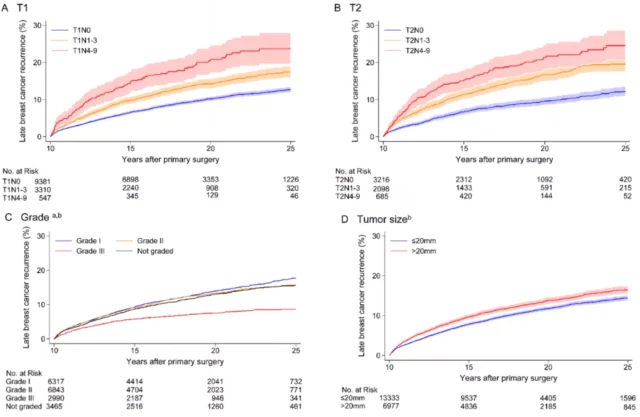
Baseline lymph node involvement, tumor grade, tumor size, cumulative incidence rate in 10-25 years
From the age of the term, breast cancer patients of different ages, the cumulative incidence is also different. Younger patients (<40 years old) have a higher cumulative incidence , a 47% increase in the risk of recurrence (HR 1.47; 95%CI 1.22-1.78), and a 117% increase in the risk of local recurrence (HR 2.17; 95%CI 1.63-2.88).
From the perspective of estrogen receptor status , the cumulative incidence of ER-positive patients is higher, ranging from 13.5% (ER-positive and T1N0) to 34.3% (ER-positive and T2N4-9) , but it cannot be ignored that ER-negative patients There is also a cumulative incidence rate of 8.1% .
Compared with ER-positive patients, the risk of recurrence in ER-negative patients was reduced by 32% (HR 0.68; 95%CI 0.59-0.79), and the risk of distal recurrence was reduced by 34%.
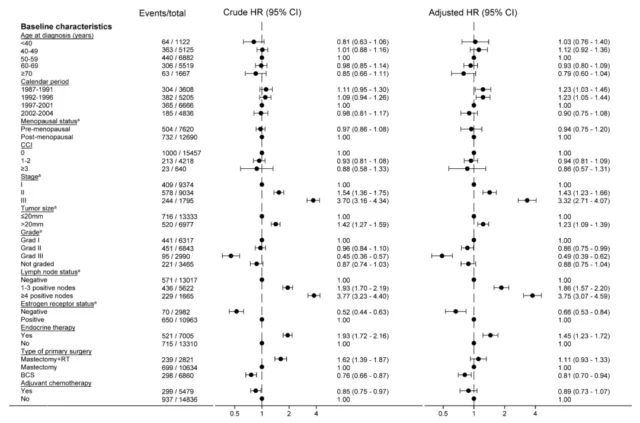
Correlation between clinicopathological factors at baseline and the risk of remote recurrence
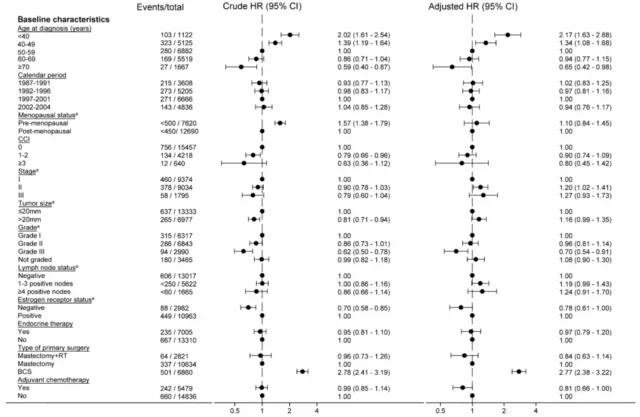
Correlation between clinicopathological factors at baseline and the risk of local recurrence
In summary, Pedersen and his colleagues found that more than 50% of women with early-stage breast cancer will not have advanced breast cancer recurrence for at least 10 years after the initial diagnosis, but they will still relapse after a long period of time. 10- The cumulative incidence in 32 years reached 16.6% .
Moreover, when breast cancer patients are initially diagnosed as having the characteristics of too large tumor diameter (≥20mm), tumor histology grade I/II, more positive lymph nodes (≥4), and ER positive features, there will be Higher cumulative incidence of advanced breast cancer and the risk of recurrence .
They proposed that more extensive monitoring or more active and advanced treatments should be given to these patients.
Unexpectedly, the researchers found that adjuvant endocrine therapy actually increased the risk of late recurrence. In this study, for ER-positive patients, adjuvant endocrine therapy failed, and the risk of recurrence was not affected; for those patients whose estrogen receptor status was not confirmed at the time of diagnosis, they received 1-2 years After the adjuvant endocrine therapy, the risk of recurrence of advanced breast cancer is increased.
In this regard, Pedersen and his colleagues believe that this may be somewhat different from the current guidelines for adjuvant endocrine therapy.
With the advancement of medical level and technology, more and more breast cancer patients have survived, but at the same time they have to face a new challenge: how to deal with the high cumulative incidence of advanced breast cancer.
After all, long-term treatment or follow-up can be considered to be more physical and mental, and it is imminent to distinguish people with a higher risk of recurrence of advanced breast cancer.
references:
[1]Peto R, Boreham J, Clarke M, Davies C, Beral V. UK and USA breast cancer deaths down 25% in year 2000 at ages 20-69 years. Lancet Lond Engl. 2000;355(9217):1822. doi:10.1016/S0140-6736(00)02277-7
[2]Dowling RJO, Kalinsky K, Hayes DF, et al. Toronto Workshop on Late Recurrence in Estrogen Receptor-Positive Breast Cancer: Part 1: Late Recurrence: Current Understanding, Clinical Considerations. JNCI Cancer Spectr. 2019;3(4) :pkz050. doi:10.1093/jncics/pkz050
[3]Howell A, Cuzick J, Baum M, et al. Results of the ATAC (Arimidex, Tamoxifen, Alone or in Combination) trial after completion of 5 years’ adjuvant treatment for breast cancer. Lancet Lond Engl. 2005;365( 9453):60-62. doi:10.1016/S0140-6736(04)17666-6
[4]Pedersen RN, Esen BÖ, Mellemkjær L, et al. The Incidence of Breast Cancer Recurrence 10-32 Years after Primary Diagnosis. J Natl Cancer Inst. 2021 Nov 8:djab202. doi: 10.1093/jnci/djab202. Epub ahead of print. PMID: 34747484.
[5]Friberg S, Nyström A. Cancer Metastases: Early Dissemination and Late Recurrences. Cancer Growth Metastasis. 2015;8:43-49. doi:10.4137/CGM.S31244
[6]Katharina P. Tumor Cell Seeding During Surgery—Possible Contribution to Metastasis Formations. Cancers. 2011;3(4):2540-2553. doi:10.3390/cancers3022540
[7]Lyngholm CD, Laurberg T, et al. Failure pattern and survival after breast conserving therapy. Long-term results of the Danish Breast Cancer Group (DBCG) 89 TM cohort. Acta Oncol Stockh Swed. 2016;55(8): 983-992. doi:10.3109/0284186X.2016.1156741
[8]Pan H, Gray R, Braybrooke J, et al. 20-Year Risks of Breast-Cancer Recurrence after Stopping Endocrine Therapy at 5 Years. N Engl J Med. 2017;377(19):1836-1846. doi: 10.1056/NEJMoa1701830
JNCI: Why will Breast cancer still recur after 30 years?
(source:internet, reference only)
Disclaimer of medicaltrend.org
Important Note: The information provided is for informational purposes only and should not be considered as medical advice.



